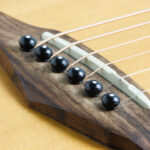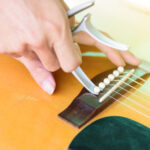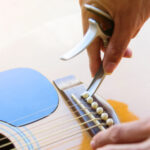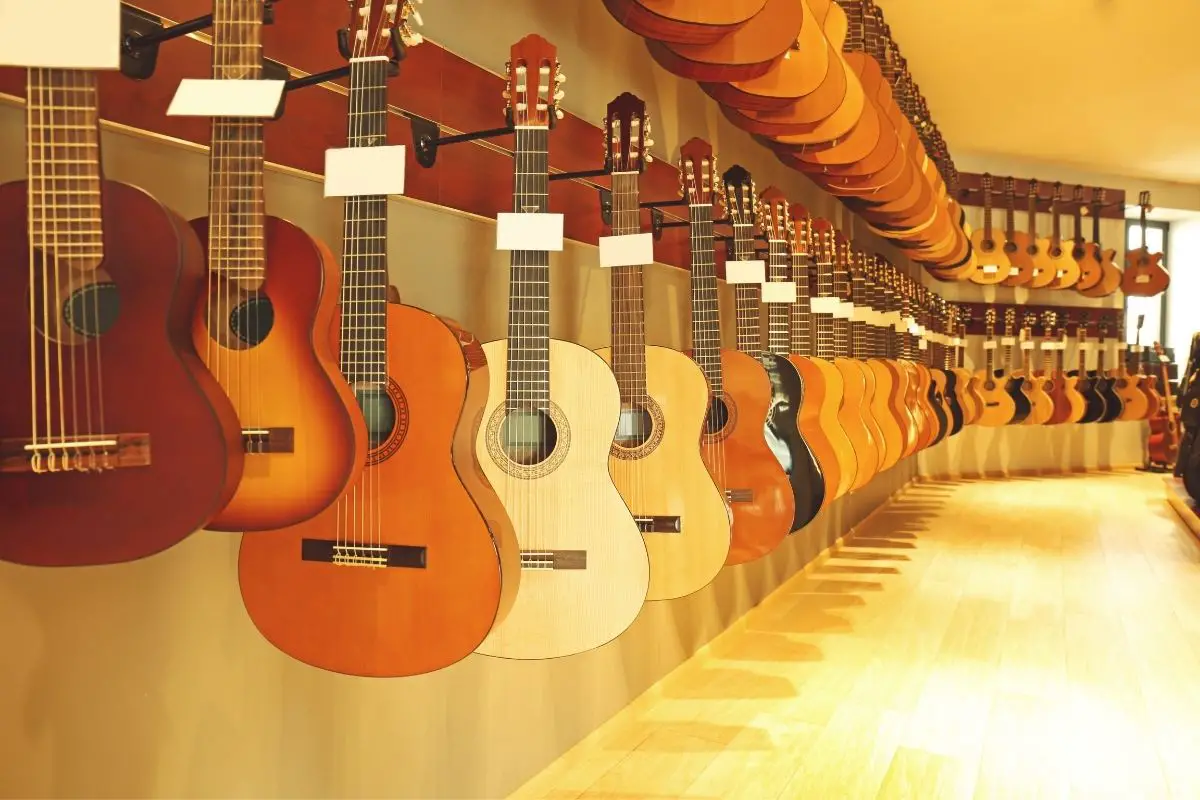Acoustic guitar players are always looking for ways to improve the sound and playability of their instruments. One topic that often comes up is the role of bridge pins. Do they make a difference in the sound and tone of the guitar?
Understanding the role of bridge pins in acoustic guitars is important for any player looking to improve their guitar’s sound. Bridge pins are small pegs that hold the strings in place at the bridge of the guitar. They come in a variety of materials, including plastic, bone, and brass.
While they may seem like a small part of the guitar, they can have a significant impact on the overall sound and playability of the instrument.
The impact of bridge pins on guitar tone is a topic of much debate among guitar players. Some claim that certain materials, such as bone or brass, can improve the sustain and volume of the guitar. Others argue that the fit and size of the bridge pins are more important than the material.
In this article, we will explore the different materials of bridge pins, the effect they have on sustain and volume, and the influence they have on the aesthetics of the guitar.
Key Takeaways on Do Acoustic Guitar Bridge Pins Make a Difference?
- Bridge pins can have a significant impact on the sound and playability of an acoustic guitar.
- Different materials of bridge pins can affect sustain and volume.
- The fit and size of bridge pins are also important factors to consider.
Check out these other popular posts in this category:
- 5 Best Bridge Pins For Acoustic Guitar (Comparison & Reviews)
- What is the Best Material for Acoustic Guitar Bridge Pins?
- What is the Difference Between Mini and Baby Guitars?
Understanding the Role of Bridge Pins in Acoustic Guitars

Bridge pins are small components that play an important role in the overall sound of an acoustic guitar. These pins are located at the bridge of the guitar, which is the part of the instrument that holds the strings in place.
The bridge pins hold the strings in place and anchor them to the bridge, which helps to transfer the vibrations of the strings to the guitar body, creating the sound that we hear.
Bridge pins can be made of various materials, including plastic, bone, ivory, and wood. The material that the bridge pins are made of can affect the overall sound of the guitar.
For example, some guitarists believe that bone or ivory bridge pins produce a brighter and more defined sound than plastic bridge pins.
The shape and size of the bridge pins can also affect the sound of the guitar. Some bridge pins are tapered, which means that they get wider toward the bottom.
This design can help to improve the transfer of vibration from the strings to the guitar body, resulting in a more resonant and full-bodied sound.
The Impact of Bridge Pins on Guitar Tone
Bridge pins are small components that hold the strings in place on an acoustic guitar. Many guitar players wonder if changing their bridge pins will have an impact on their guitar’s tone. In short, the answer is yes, but the extent of the impact will depend on a variety of factors.
First and foremost, it’s important to note that bridge pins do not create tone on their own. Instead, they affect the way the strings vibrate, which in turn affects the overall sound of the guitar. Specifically, the material and shape of the bridge pins can impact the guitar’s tone in the following ways:
- Bass and Treble: Changing the material and shape of the bridge pins can affect the balance of bass and treble in the guitar’s sound. For example, brass bridge pins may produce a more bass-heavy sound, while ebony bridge pins may produce a brighter sound with more emphasis on treble.
- Overtones: Bridge pins can also affect the guitar’s overtones, which are the harmonic overtones that give a guitar its unique sound. Different materials and shapes can emphasize or de-emphasize certain overtones, which can give the guitar a distinct character.
- Sustain: The material and shape of the bridge pins can also affect the guitar’s sustain, or how long a note rings out. For example, bridge pins made of denser materials may produce longer sustain than those made of lighter materials.
It’s important to note that the impact of bridge pins on guitar tone is subtle. For most players, the difference in sound will be minor and may not be noticeable without careful listening.
Additionally, other factors such as the guitar’s body shape, wood type, and strings will also have a significant impact on the guitar’s overall tone.
Different Materials of Bridge Pins
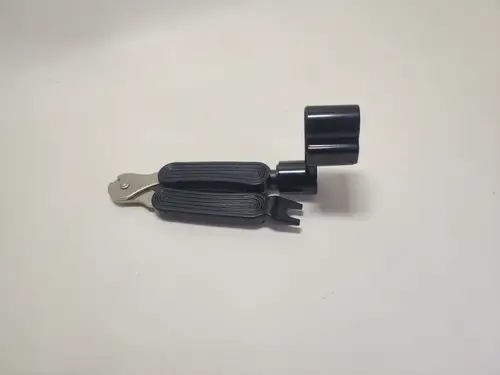
Acoustic guitar bridge pins come in various materials, and each material has a unique effect on the tone and sustain of the guitar. Here are some of the most common materials used for bridge pins:
1. Plastic
Plastic is the most common material used for bridge pins. They are affordable and easy to manufacture, making them a popular choice for entry-level guitars. Plastic bridge pins are lightweight and do not add much to the guitar’s tonal quality.
2. Bone
Bone bridge pins are popular among guitarists who prefer a warmer and more natural sound. They provide a richer and more resonant tone than plastic bridge pins. Bone is also a durable material that can last for a long time.
3, Ebony
Ebony bridge pins are known for their dense and heavy properties, which contribute to a brighter and more articulate tone. They are also visually appealing, with their dark and smooth finish.
4, Brass
Brass bridge pins are heavier than plastic and bone, which can add sustain and depth to the guitar’s sound. They also have a bright and metallic tone that can complement certain playing styles.
5. Wood
Wooden bridge pins can be made from various types of wood, including mahogany, rosewood, and persimmon. They can add warmth and depth to the guitar’s sound, depending on the type of wood used.
6. Other Materials
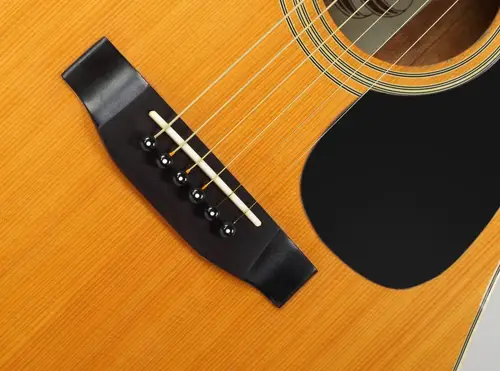
Some guitarists prefer to use more exotic materials for their bridge pins, such as ivory, mammoth ivory, abalone inlay, fossilized walrus jawbone, and buffalo horn. These materials can have unique sonic properties and add a touch of individuality to the guitar’s appearance.
Effect of Bridge Pins on Sustain and Volume
Acoustic guitar players often wonder whether the type of bridge pins they use can make a difference in the sound of their instrument.
While there are many different materials and designs available, the most common types are plastic, bone, and brass. Each material has its own unique properties that can affect the sustain and volume of the guitar.
One of the most significant factors that can affect sustain is the amount of vibration that is transferred from the strings to the guitar body. When the strings vibrate, they create sound waves that travel through the guitar body and out through the sound hole.
The bridge pins play an essential role in this process by holding the strings in place and transferring their vibrations to the bridge and the guitar body.
Plastic bridge pins are the most common type of pins found on acoustic guitars. While they are inexpensive and easy to replace, they may not provide the best sustain or volume.
Plastic is a relatively soft material that can absorb some of the string vibrations, which can result in a less vibrant and full sound.
Bone bridge pins are a popular upgrade for guitar players looking to improve sustain and volume. Bone is a denser material than plastic and can transmit more of the string vibrations to the guitar body. This increased transmission can result in a more resonant and sustained sound.
Brass bridge pins are another option for guitar players looking to enhance sustain and volume. Brass is a very dense material that can transfer even more string vibrations to the guitar body than bone. This increased transmission can result in a very bright and sustained sound with a lot of resonance.
The Fit and Size of Bridge Pins
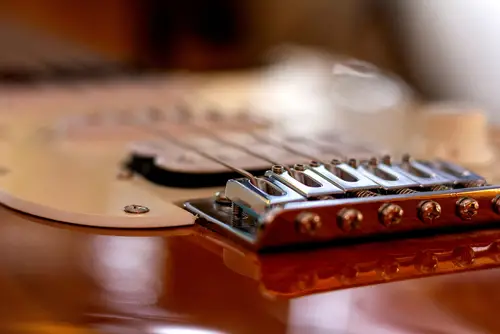
When it comes to acoustic guitar bridge pins, the fit and size of the pins can make a difference in the sound and playability of the guitar. The pins are responsible for holding the strings in place at the bridge, and the fit and size of the pins can affect the tension and tone of the strings.
The fit of the bridge pins is important because it determines how tightly the strings are held in place. If the pins are too loose, the strings can slip out of place, causing tuning issues and affecting the tone of the guitar.
On the other hand, if the pins are too tight, the strings can be under too much tension, which can affect the intonation and playability of the guitar.
In terms of size, bridge pins come in different diameters to match the size of the string hole in the bridge. It’s important to use the correct size of bridge pin to ensure a snug fit and proper tension of the strings. Bridge pins are typically available in sizes ranging from 4mm to 6mm in diameter.
Bridge pins also come in different styles, including slotted and unslotted pins. Slotted pins have a slot in the top where the string is inserted, while unslotted pins do not have a slot. Some bridge pins also have a ball end, which helps to hold the string in place.
Influence of Bridge Pins on Aesthetics of the Guitar
Bridge pins are an integral part of acoustic guitars, and they play a significant role in the overall aesthetics of the guitar. The pins are visible on the bridge of the guitar, and they come in various materials, colors, and shapes.
The choice of bridge pins can affect the appearance of the guitar, and it is essential to choose the right pins that complement the guitar’s look.
The color of the bridge pins can make a difference in the guitar’s aesthetics. Some guitarists prefer to match the color of the bridge pins with the guitar’s body, while others choose contrasting colors to create a unique look.
The material of the bridge pins can also affect the guitar’s appearance. Bridge pins made of bone or ivory can give the guitar a classic and traditional look, while bridge pins made of plastic or metal can give the guitar a modern and contemporary look.
The shape of the bridge pins can also influence the guitar’s aesthetics. Some bridge pins have a traditional shape, while others have a unique design. The shape of the bridge pins can complement the guitar’s body shape and enhance its overall appearance.
Bridge Pins and Guitar Maintenance
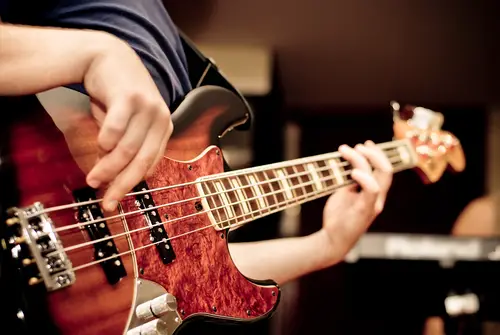
Bridge pins are small components that hold the strings in place at the bridge of an acoustic guitar. They are often overlooked, but they play an important role in the overall sound and playability of the instrument.
Proper maintenance of bridge pins can help ensure that the guitar stays in tune and sounds its best.
Humidity and temperature can affect the durability of bridge pins. Extreme changes in temperature or humidity can cause the wood to expand or contract, which can cause the bridge pins to loosen or become stuck.
It is important to keep the guitar in a stable environment to prevent damage to the bridge pins.
Over time, bridge pins can wear out and become less effective at holding the strings in place. This can cause the guitar to go out of tune more frequently and can also affect the overall tone of the instrument.
It is recommended to replace bridge pins every few years to maintain optimal performance.
When replacing bridge pins, it is important to choose high-quality pins that are made from durable materials. Plastic bridge pins are more affordable, but they may wear out faster than pins made from bone or other materials.
It is also important to select bridge pins that are the correct size and shape for the guitar.
Conclusion
After conducting research on the topic of whether acoustic guitar bridge pins make a difference, the answer is not clear-cut. While some guitarists swear by certain types of bridge pins, others claim that they do not make a noticeable difference in sound or playability.
However, it is important to note that the material and design of the bridge pins can affect the overall tone and sustain of the guitar. For example, brass bridge pins may produce a brighter sound, while ebony bridge pins may produce a warmer sound.
Ultimately, the decision to use certain bridge pins comes down to personal preference. Guitarists should experiment with different types of bridge pins to determine which ones work best for their playing style and desired sound.
It is also important to ensure that the bridge pins fit properly in the guitar’s bridge and do not cause any damage to the instrument. If in doubt, it is recommended to consult with a professional guitar technician.
Frequently Asked Questions
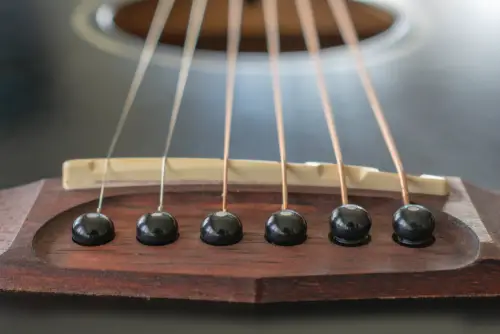
Do different bridge pins affect the sound of an acoustic guitar?
Yes, different bridge pins can affect the sound of an acoustic guitar. The material, shape, and weight of the bridge pins can all have an impact on the tone and sustain of the guitar.
Are brass bridge pins better than plastic ones for acoustic guitars?
It depends on the player’s preference. Brass bridge pins are heavier than plastic ones, which can result in a slightly brighter and louder tone. However, plastic bridge pins are more affordable and can still produce a good sound.
What are the benefits of using TUSQ bridge pins on an acoustic guitar?
TUSQ bridge pins are made from a synthetic material that is designed to mimic the sound and feel of natural bone. They are known for producing a clear and balanced tone, as well as improving sustain and harmonics.
Can changing the bridge pins on my acoustic guitar improve its tone?
Yes, changing the bridge pins on an acoustic guitar can improve its tone. However, it is important to note that the overall sound of the guitar is influenced by many factors, including the quality of the wood, the strings, and the player’s technique.
Are ivory bridge pins worth the investment for an acoustic guitar?
No, ivory bridge pins are not worth the investment. In addition to being illegal in many countries, ivory is not a sustainable or ethical material.
There are many high-quality synthetic and natural materials available that can produce a great sound without harming endangered species.
Is it easy to replace the bridge pins on an acoustic guitar?
Yes, replacing bridge pins on an acoustic guitar is a relatively simple process. It can be done by gently pulling the old pins out and inserting the new ones.
However, it is important to use the correct size and shape of pins for the guitar to avoid damaging the bridge or affecting the sound.

My name is Howard Matthews and I have been playing the guitar since I was knee-high. My parents like to joke that I was pulling the strings even before I was born. In fact, one of my earliest memories is sitting on the couch with my dad’s guitar, wreaking havoc on the chords.
Now, 40 years later, I can attest that I play them much better than I did back then. I have followed in the footsteps of both my parents – much to their delight – and have been the main guitarist in my band for the best part of three decades.
Music has always been my passion, and until recently my life has been so consumed with it that I haven’t had a moment to have a breath (and I wouldn’t have it any other way)!

